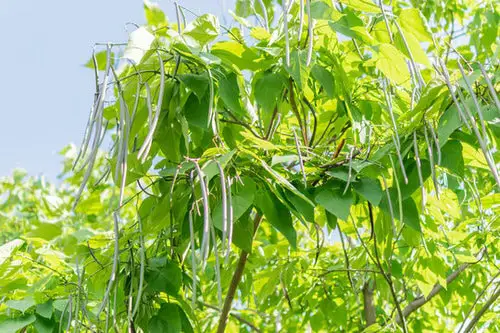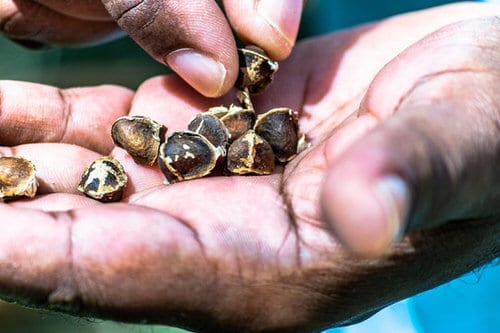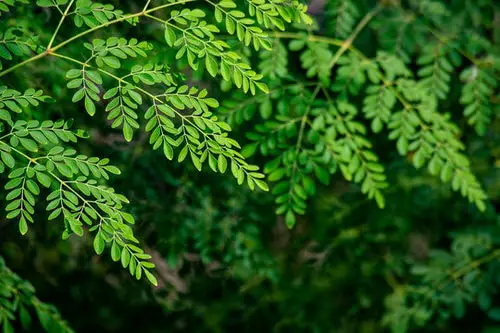Also called the ‘Tree of Life’ because of its contribution to our health and lives, Growing Moringa Tree is rewarding, simple, and easy.

Moringa tree, also popularly known as Drumstick Plant, is a fast-growing tree from the family Moringaceae that is native to the Indian subcontinent drought-resistant. There are more than 13 species of this tree, and all parts of it are used as medicine or food in different parts of the world.
USDA Zones: 9 – 11
Difficulty: Easy to Moderate
Other Names: Mallungay, munga, munge, Moringa, Shobhanjana, ben oil tree, benzolive tree, horseradish tree, drumstick plant, miracle tree, the never die tree.
Growing Moringa Tree

From Cutting
- Take a 4-6 feet long cutting from a healthy tree. Snip away the lower leaves and plant it in a 3 feet X 3 feet hole, making sure it goes at least 3 feet deep in the ground. Pick a location that gets bright, indirect sunlight.
- Pour in the soil, aged manure, and sand mix. Pack firmly.
- Water well and make sure the cutting is not disturbed. It will form roots in 6-8 weeks.
From Seeds
Do not plant Moringa seeds during the colder months when the temperature drops below 60 °F or 15.5 °C.
- Plant the seeds straight away at the spot where you would want the tree to grow because the immature seedlings often cannot survive transplanting, as they are pretty delicate.
- Choose a spot that gets bright, indirect light and sow the seeds directly in the ground. Mixing aged manure or the compost in the ground will help the tree grow better, even though Moringa tees can survive in poor soils.
- The topsoil should be kept moist enough not to choke the new saplings. Do not overwater, or else there is the risk of seeds drowning and rotting.
- Sow 3-5 seeds to increase the chances of germination.
- Once the saplings reach 4-6 inches in height, just let the healthiest saplings stay in the ground and remove the rest.
- Initially, be careful of nematodes and termites that can kill a young, tender sapling. Take precautions to safeguard the sapling from these dangers.
Requirements for Growing Moringa Tree
Location
Plant moringa tree in a location that is less windy and receives at least 5-6 hours of sunlight daily. Once established, the tree will tolerate sun and shade.
Soil
The tree does well in regular garden soil. At the time of the growth, you can add organic matter to boost the growth rate.
Watering
Water the plant moderately when it is young. Once established you don’t need to water it unless there is severe drought conditions.
Fertilizer
When growing a moringa tree, you don’t need to fertilize it. Instead, feed the plant with manure or compost and it will thrive well. If the plant is not growing well, you can apply general-purpose fertilizer during the growing period.
Growing Moringa Tree in Temperate Region

You can grow it in a temperate climate but with some restrictions, as it needs care in winter. It is not a frost tolerant plant so it is better to grow it in a large container in the sunniest spot of your garden. In colder zones, grow it as an annual from spring to fall.
Moringa Tree Care
- Keep the planting space weed-free and pest-free. If you happen to spot any pests, rinse them off using a water pipe or hose.
- Trim off older branches to encourage the growth of fruits as the tree matures.
- In the first year, remove the flowers as they bloom to promote fruiting in the following years.
- Annual pruning to a shrub shape will help to keep the growth under control.
Health Benefits of the Moringa Tree

This beautiful tree can impact your health with its numerous health benefits. It is the main reason why many health organizations worldwide are encouraging underdeveloped countries to plant and distribute Moringa trees to make up for the missing nutrients in malnutrition people.
- To meet the daily need for Vitamins C and A, eat a half cup of its cooked leaves.
- To keep the supply maintained of your daily requirement of Vitamin C daily, have a half cup of pods (raw).
- Only one ounce of raw leaves can give you the recommended daily dose of Vitamin C.
- The leaves are rich in beta-carotene. It contains 3-5 times more than what carrots have to offer!
- Three ounces of Moringa powder can give you over ten times the suggested daily dose of Vitamin E, ounce per ounce.
- The leaves have thrice the amount of potassium than bananas have.
- The Moringa leaves contain 6-7 times the amount of Vitamin C that a glass of orange juice has.
- The leaves have over three times the iron content compared to found in spinach or roast beef, ounce for ounce.
- One ounce of Moringa leaves contains four times the amount of calcium in one ounce of milk.



Thank you for sharing. I purchase dumstick from a local Asian focused grocery store. They sell the leaves and the stems. How I use it: add to the cooking bone broth when I add the vegetables, mix in the scrambled eggs and other dishes.
Your post gave me more insight, and I am going to work on purchasing a plant, and give it a go at growing my own plant.
I have three trees in my back yard in the middle east and I use the leaves in my chickpea flour pancake batter, in my chapati dough, add them to my dhals and I was wondering if I will be able to find them in Canada. Just found from your site that it’s available on amazon.com. Thank you for the info.
Glad to hear that we helped you.
Thank you for sharing, Moringa is wonderful @ http://www.HealingMoringaTree.com
I Am trying ti find Growing-Artichokes. ?…….How di I ask this Great site
Hi Gianni, You can find out how to grow artichokes here.
Thank you for sharing. My moringa grew to about 20 ft and was beginning to flower but the wind broke it down from the stem. I use the leaves for soup, and stem for tooth whitening. The oil is great on the face abd for cuts or wounds.
Where can you suggest that I can buy a moringa plant (potted) to nurse in a flat in the UK? Grateful for your assistance